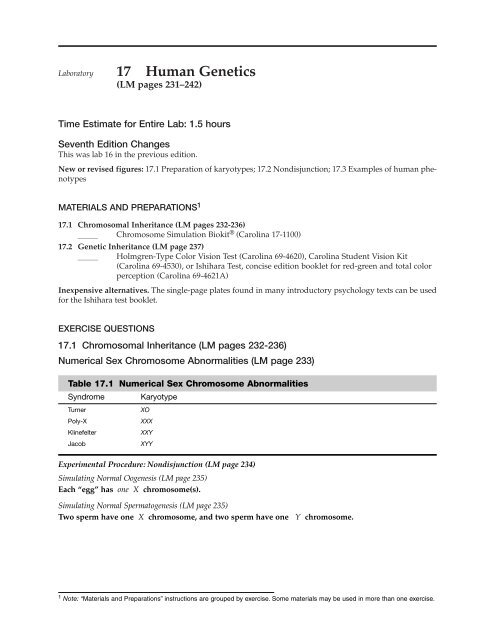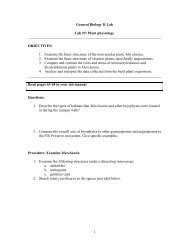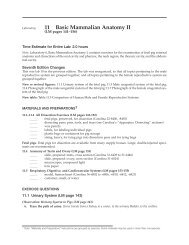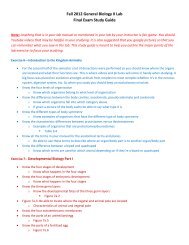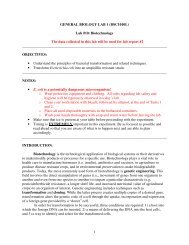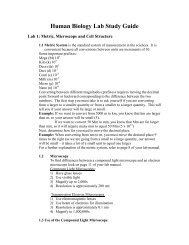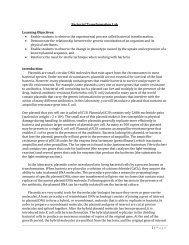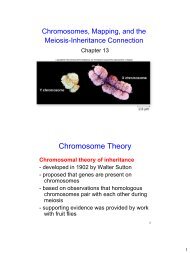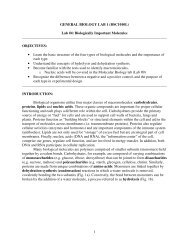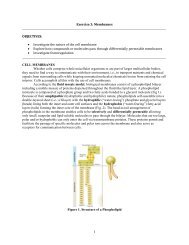17 Human Genetics
17 Human Genetics
17 Human Genetics
You also want an ePaper? Increase the reach of your titles
YUMPU automatically turns print PDFs into web optimized ePapers that Google loves.
Laboratory <strong>17</strong> <strong>Human</strong> <strong>Genetics</strong><br />
(LM pages 231–242)<br />
Time Estimate for Entire Lab: 1.5 hours<br />
Seventh Edition Changes<br />
This was lab 16 in the previous edition.<br />
New or revised figures: <strong>17</strong>.1 Preparation of karyotypes; <strong>17</strong>.2 Nondisjunction; <strong>17</strong>.3 Examples of human phenotypes<br />
MATERIALS AND PREPARATIONS 1<br />
<strong>17</strong>.1 Chromosomal Inheritance (LM pages 232-236)<br />
_____ Chromosome Simulation Biokit ® (Carolina <strong>17</strong>-1100)<br />
<strong>17</strong>.2 Genetic Inheritance (LM page 237)<br />
_____ Holmgren-Type Color Vision Test (Carolina 69-4620), Carolina Student Vision Kit<br />
(Carolina 69-4530), or Ishihara Test, concise edition booklet for red-green and total color<br />
perception (Carolina 69-4621A)<br />
Inexpensive alternatives. The single-page plates found in many introductory psychology texts can be used<br />
for the Ishihara test booklet.<br />
EXERCISE QUESTIONS<br />
<strong>17</strong>.1 Chromosomal Inheritance (LM pages 232-236)<br />
Numerical Sex Chromosome Abnormalities (LM page 233)<br />
Table <strong>17</strong>.1 Numerical Sex Chromosome Abnormalities<br />
Syndrome Karyotype<br />
Turner XO<br />
Poly-X XXX<br />
Klinefelter XXY<br />
Jacob XYY<br />
Experimental Procedure: Nondisjunction (LM page 234)<br />
Simulating Normal Oogenesis (LM page 235)<br />
Each “egg” has one X chromosome(s).<br />
Simulating Normal Spermatogenesis (LM page 235)<br />
Two sperm have one X chromosome, and two sperm have one Y chromosome.<br />
1 Note: “Materials and Preparations” instructions are grouped by exercise. Some materials may be used in more than one exercise.
70<br />
Simulating Fertilization (LM page 235)<br />
Use a Punnett square and fill in the products of fertilization using the type of gametes that resulted<br />
from normal oogenesis and the types of gametes that resulted from normal spermatogenesis.<br />
X Y<br />
X XX XY<br />
Simulating Nondisjunction During Meiosis I (LM page 235)<br />
1. What is the chromosome constitution of each of the four meiotic products<br />
for spermatogenesis? for oogenesis?<br />
XY XY<br />
XX<br />
Further note that each egg having chromosomes has one red chromosome and one blue chromosome.<br />
2. Use a Punnett square and fill in the products of fertilization using<br />
(a) normal sperm types of abnormal eggs, as in Figure <strong>17</strong>.2a, and (b) normal egg types of<br />
abnormal sperm, as in Figure <strong>17</strong>.2b (top).<br />
a. b.<br />
X Y O XY<br />
XX XXX XXY X XO XXY<br />
O XO YO<br />
Conclusions (LM page 236)<br />
• What syndromes are the result of (a)? poly-X (XXX), Klinefelter syndrome (XXY), Turner<br />
syndrome XO, and YO<br />
• Are all offspring viable? no Explain. YO is not viable because it lacks an X chromosome.<br />
• What syndromes are the result of (b)? Klinefelter syndrome (XXY) and Turner syndrome (XO)<br />
• Are all offspring viable? yes Explain. Having even one X chromosome allows offspring to be viable.<br />
Simulating Nondisjunction During Meiosis II (LM page 236)<br />
1. What is the chromosome constitution of each of the four meiotic products<br />
for spermatogenesis? for oogenesis?<br />
XX YY XX XX<br />
2. Use a Punnett square and fill in the products of fertilization using (a) normal sperm types of abnormal<br />
eggs, as in Figure <strong>17</strong>.2a, and (b) normal egg types of abnormal sperm, as in Figure <strong>17</strong>.2b (bottom).<br />
a. b.<br />
X Y<br />
XX XXX XXY X XXX XYY XO<br />
O XO YO<br />
XX YY O<br />
XX
Conclusions (LM page 236)<br />
• What syndromes are the result of (a)? poly-X (XXX), Klinefelter syndrome (XXY), Turner syndrome<br />
(XO), and YO<br />
• Are all offspring viable? no Explain. YO is not viable.<br />
• What syndromes are the result of (b)? poly-X (XXX), Jacob syndrome (XYY), Turner syndrome (XO)<br />
• Are all offspring viable? yes Explain. All have at least one X chromosome.<br />
<strong>17</strong>.2 Genetic Inheritance (LM page 237)<br />
Autosomal Dominant and Recessive Traits (LM pages 237-239)<br />
Experimental Procedure: Autosomal Traits (LM page 237-238)<br />
4. Are dominant phenotypes always the most common in a population? no Explain. The prevalent<br />
phenotypes depend on the genes of the founding members of the population.<br />
Table <strong>17</strong>.2 Autosomal <strong>Human</strong> Traits<br />
Answers may vary according to the class members. Students may not know whether they are homozygous dominant or heterozygous.<br />
If so, they can use A? for their genotype, for example.<br />
<strong>Genetics</strong> Problems (LM page 238)<br />
1. Nancy and the members of her immediate family have attached earlobes. Her maternal grandfather<br />
has unattached earlobes. What is the genotype of her maternal grandfather? Uu Nancy’s<br />
mother has the genotype uu (results in the recessive phenotype), therefore her maternal granfather who has<br />
unattached earlobes must be Uu. Nancy’s maternal grandmother is no longer living. What could have<br />
been the genotype of her maternal grandmother? Nancy’s mother must have also inherited a u from her<br />
mother, who could have been Uu or uu.<br />
2. Joe does not have a bent little finger, but his parents do. What is the expected ratio among the<br />
parents’ children? Joe’s genotype is ll (results in the recessive phenotype); therefore, his parents who have<br />
bent little fingers must be Ll. The expected ratio among their children would be 3:1, or 75% with bent little finger<br />
and 25% with straight little finger.<br />
3. Henry is adopted. He has hair on the back of his hand. Could both of his parents have had hair<br />
on the back of the hand? yes Could both of his parents have had no hair on the back of the hand?<br />
no Explain. The presence of hair on the back of the hand is a dominant characteristic; at least one parent had<br />
to have hair on the back of the hand for Henry to have it.<br />
Sex Linkage (LM page 239)<br />
Experimental Procedure: X-Linked Traits (LM page 239)<br />
3. Are you color blind? Results will depend on the individual student. If so, what is your genotype?<br />
Female: X b X b ; Male: X b Y<br />
4. If you are a female and are not color blind:<br />
If your father is color blind, what is your genotype? X B X b<br />
If your mother is color blind, what is your genotype? X B X b<br />
If you know of no one in your family who is color blind, what is your probable genotype?<br />
X B X B<br />
<strong>Genetics</strong> Problems (LM page 239)<br />
1. The only color-blind member of Arlene’s family is her brother.<br />
What is her brother’s genotype? X b Y<br />
What is her father’s genotype? X B Y<br />
What is her mother’s genotype? X B X b<br />
What is Arlene’s genotype if she later has a color-blind son? X B X b<br />
71
72<br />
2. (Klinefelter syndrome/color blindness): In which parent and at what meiotic division did sex<br />
chromosome nondisjunction occur? The father is not color blind; therefore color blindness was inherited<br />
from his mother, who is X B X b . If nondisjunction occurred during meiosis I, he would have inherited a X B and<br />
would not be color blind. Since this male is color blind, we know that nondisjunction occurred during meiosis<br />
II.<br />
3. (Turner syndrome/hemophilia): In which parent did nondisjunction occur, considering that the<br />
single X came from the father? Nondisjunction occurred in the mother. Is it possible to tell if nondisjunction<br />
occurred during meiosis I or meiosis II? no Explain. Hemophilia was not passed on by the<br />
mother, and nondisjunction in the mother during meiosis I or meiosis II produces the same types of meiotic<br />
products.<br />
Pedigree Charts (LM pages 240-241)<br />
Pedigree Chart Analyses (LM page 240)<br />
1. a. What is the inheritance pattern for this genetic disorder? The inheritance pattern is autosomal<br />
recessive. The two parents of generation I are unaffected, and yet, two daughters are affected. These<br />
observations rule out autosomal dominant and X-linked recessive.<br />
b. What is the genotype of the following individuals?<br />
Generation I, individual 1: Aa This individual has to be heterozygous because some of the children are<br />
affected.<br />
Generation II, individual 1: aa This individual has to be homozygous recessive because he is affected.<br />
Generation III, individual 8: Aa This has to be the case because the mother is homozygous recessive, and<br />
the individual has to inherit at least one of her recessive alleles.<br />
2. a. What is the inheritance pattern for this genetic disorder? The inheritance pattern is X-linked recessive.<br />
This has to be the case because only the males are affected, and the trait skips generations. (Note: if a trait<br />
is Y-linked, only the males are affected, but the trait is in every generation.)<br />
b. What is the genotype of the following individuals?<br />
Generation I, individual 1: X A X a This female has to be a carrier because she has an affected son.<br />
Generation II, individual 8: X A X ? Unable to determine whether this female is a carrier or not because she<br />
had no children.<br />
Generation III, individual 1: X A Y This male is unaffected; therefore, he must have received a dominant<br />
allele.<br />
3. a. What is the inheritance pattern for this genetic characteristic? The inheritance pattern is autosomal<br />
dominant. X-linked recessive is ruled out because sibling males and females are affected equally. In the far right<br />
family of the second generation, both mother and father are affected. One son is not affected. It can be deduced,<br />
then, that both parents are heterozygous.<br />
b. What is the genotype of the following individuals?<br />
Generation I, individual 1: Aa This individual has to be heterozygous because some children are<br />
unaffected.<br />
Generation II, individual 7: aa This individual is unaffected and inherited a recessive allele from both<br />
parents.<br />
Generation III, individual 4: aa This individual is unaffected and inherited a recessive allele from both parents.<br />
Generation III, individual 11: Aa This individual is homozygous dominant because all of his children are<br />
affected.
LABORATORY REVIEW <strong>17</strong> (LM page 242)<br />
1. What term refers to paired chromosomes arranged by size and shape? karyotype<br />
2. What pair of chromosomes is not homologous in a normal male karyotype? sex chromosomes<br />
3. What syndrome is inherited when an egg carrying two X chromosomes is fertilized by a sperm<br />
carrying one Y chromosome? Klinefelter syndrome<br />
4. What abnormal meiotic event leads to the syndrome described in question 3? In which parent?<br />
nondisjunction in the mother<br />
5. What two types of sperm result if nondisjunction of sex chromosomes occurs during meiosis I of<br />
spermatogenesis? XY sperm and sperm containing no sex chromosomes<br />
6. Name a common autosomal trisomy? Down syndrome<br />
7. What does a geneticist construct to show the inheritance pattern of a genetic disorder within a<br />
family? pedigree chart<br />
8. If an individual exhibits the dominant characteristic, what two genotypes are possible? homozygous<br />
dominant and heterozygous<br />
9. What is the genotype of a man who has unattached earlobes but whose mother has attached earlobes?<br />
Uu<br />
10. Which parent, regardless of the phenotype, is responsible for color blindness in a son? mother<br />
11. If only males are affected in a pedigree chart, what is the likely pattern of inheritance for the<br />
trait? X-linked recessive<br />
12. If the parents are not affected and a child is affected, what is the pattern of inheritance? autosomal<br />
recessive<br />
Thought Questions<br />
13. An egg contains two X chromosomes that carry the same alleles. Did nondisjunction take place<br />
during meiosis I or meiosis II? Explain. during meiosis II, when sister chromatids fail to separate<br />
14. What pattern of inheritance in a pedigree chart would allow you to decide that a characteristic is<br />
X-linked? A characteristic is X-linked if it passes from grandfather to grandson.<br />
73


